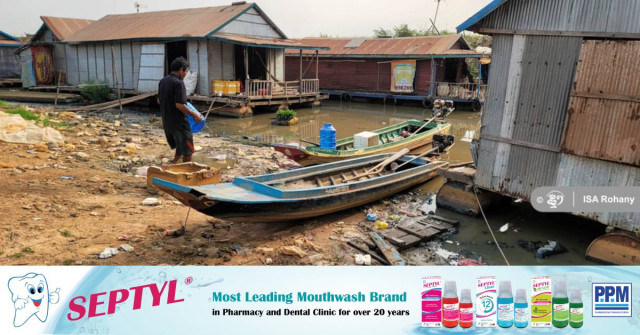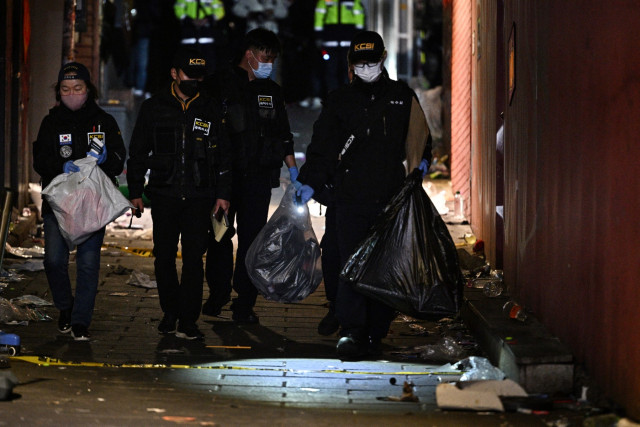Disease Plagues River Families Facing Clean Water Crisis

- By Isa Rohany
- April 9, 2024 2:00 PM
SIEM REAP – Residents at the floating village of Chong Kneas in Siem Reap province are battling diseases and pollution amid a shortage of clean water as the dry season turns the Tonle Sap near their homes into a sea of toxic mud.
Trash on the riverbed such as kitchen waste, toilet waste and plastic bags cause respiratory problems and intestinal diseases as the water level drops and sanitation is poor.
Kea Sokun’s year-old daughter had breathing and lung problems as toxic fumes were found in her lungs, medical staff told the mother.
Sokun, 33, was not surprised as the area where she lived in had been polluted by smoke and plastic bags and had an unclean environment.
She said her baby was diagnosed with respiratory illness five months after birth and had to stay in hospital once a month due to congenital lung disease, making it difficult for her to breathe.
“The doctor checked that she was breathing in toxic fumes. He told me not to burn plastic rubbish and tires because it is very dangerous,” she said.
Sokun's children also had asthma. Their frequent illnesses meant that the living conditions of the family did not improve much. Her husband went fishing until the evening but only caught enough for medicines and medical bills.
 Kea Sokun’s year-old daughter had breathing and lung problems as toxic fumes were found in her lungs, medical staff told the mother. Photo_ Isa Rohany
Kea Sokun’s year-old daughter had breathing and lung problems as toxic fumes were found in her lungs, medical staff told the mother. Photo_ Isa Rohany
Prek Chong Kneas narrows in the dry season and makes the houses of the mainland fishermen stand on less than half a meter of muddy soil. The water turns red and has a foul odor.
“It smells very bad. It stinks,” said Kea Sokun. “I don’t know what to do because I have no land other than where I live right now. I am desperately waiting for the rainy season.
“Children often get sick because there is lots of trash, causing mosquitos to hatch. Children often suffer from typhoid fever, gastroenteritis, influenza, and dengue fever.”
As the creek water stinks and cannot be used in this season, Sokun's family use the water from a well dug at the mouth of the creek for bathing, washing clothes and general cleaning.
For consumption, she buys a large bucket of water. Since there are almost 10 members, this family has to use two buckets of water per day, which costs 2,000 riel per bucket.
Sorn Keat, 51, has been living in Chong Kneas for 30 years. She also complains about spending money on water in this season. In addition to spending 4,000 riel a day on clean drinking water, she also complains about the difficult life.
“Fish are also scarce, but you have to spend money to buy clean water because you do not want to get sick,” she said.
Pointing to a farm at the bank, Sorn Keat said farmers sprayed pesticides, some of which flowed into the water and spread through the atmosphere, causing respiratory diseases among villagers.
 Sorn Keat, 51, has been living in Chong Kneas for 30 years. She also complains about spending money on water in this season. Photo_ Isa Rohany
Sorn Keat, 51, has been living in Chong Kneas for 30 years. She also complains about spending money on water in this season. Photo_ Isa Rohany
The family fetches water from a well more than two meters deep but Keat wants the authorities and the Water Association to dig a large well with a proper cover,
Another resident Vann Vy, 54, was lifting a water tank he had just bought from the port and putting it on a boat to take home. He said that in the dry season, water from the well cannot be consumed due to the foul smell.
“First, we are worried about our health. The water fetched from the well can have germs,” he said.
Vann Vy said that in the dry and rainy seasons, there were problems with water consumption, especially in the rainy season when water flows from different areas and causes skin to become itchy.
“Our creek is shallow, and it is difficult to use water,” he said. “If we have a well, it’s fine. But if we don’t, we have to buy the water which costs 20,000 riels so that we can bathe.”
 Vann Vy, 54, was lifting a water tank he had just bought from the port and putting it on a boat to take home. Photo_ Isa Rohany
Vann Vy, 54, was lifting a water tank he had just bought from the port and putting it on a boat to take home. Photo_ Isa Rohany
He is also worried about illnesses that often afflict his family, such as flu, typhoid fever and fever due to drinking water and living unhygienically.
Sitting with her mother and nephews at the well, Khun Pi said that the water was only used for bathing and washing clothes and was not very clear.
Tonle Sap environmental activist Sea Sophal also expressed concern about the health of residents in the area. “Residents at the floating village usually face challenges of clean water during the dry season because the water is very muddy,” he said.
Sophal highlighted the lack of hygiene in Chong Kneas, particularly during the dry season, when people gather for water, causing discomfort and unsanitary conditions even when using it for bathing.
Chong Kneas commune chief Oum Nary said that the problem of the lack of clean water in the area of the floating houses of the fishermen had been around for a long time and had not been resolved.
Nary said that in the past, the authorities went to study the problem but only helped dig small wells for them and the water could not be drunk. They continue to buy water for consumption.
In the past, there was an organization that built a clean water station in the village and sold it at a reasonable price. However, he acknowledged that the area still faces a shortage of clean water, a major problem that should be addressed together.



Original written in Khmer for Thmey Thmey, this story was translated by Teng Yalirozy for Cambodianess.















